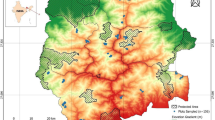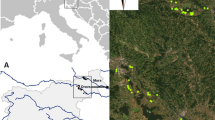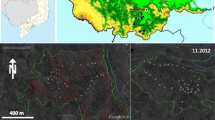Abstract
Despite their prevalence in both developed and developing countries, there have been surprisingly few field assessments of the ecological effectiveness of protected areas. This study aimed to assess the effectiveness of a key protected area in eastern Madagascar, Ranomafana National Park (RNP). We established paired 100 × 4-m vegetation transects (400 m2) within RNP and in remnant forests in the park’s peripheral zone. In each 400-m2 plot, all woody stems >1.5 cm in diameter at breast height were measured and identified to species. All species were also identified as native or non-native. We identified utilitarian species within all transects and they were sorted into use category. We calculated plot-level taxonomic biodiversity and functional diversity of utilitarian species; the latter was calculated by clustering the multivariate distances between species based on their utilitarian traits, and all metrics were tested using paired t-tests. Our results showed that there was significantly higher biodiversity inside RNP than in remnant forests and this pattern was consistent across all diversity metrics examined. Forests not located within the park’s boundary had significantly higher non-native species than within RNP. There was no statistically significant difference in functional diversity of utilitarian species inside RNP vs. remnant forests; however, the overall trend was toward higher diversity inside park boundaries. These findings suggested that RNP has been effective at maintaining taxonomic diversity relative to surrounding unprotected areas and restricting the spread of non-native plants. The results also suggested that low functional redundancy of forests outside of RNP might be of concern, because residents in surrounding villages may have few other substitutes for the services provided by species that are of critical importance to their livelihoods. This study highlights the challenges of trying to reconcile biodiversity conservation with human use of natural resources in economically poor, remote areas.





Similar content being viewed by others
References
Allen MR, Shea K (2006) Spatial segregation of congeneric invaders in central Pennsylvania, USA. Biological Invasions 8:509–521
Aragón RM, Morales JM (2003) Species composition and invasion in NW Argentinian secondary forests: effects of land use history, environment and landscape. Journal of Vegetation Science 14:195–204
Aubad J, Aragón P, Olalla-Tárraga MÁ, Rodríguez MÁ (2008) Illegal logging, landscape structure and the variation of tree species richness across North Andean forest remnants. Forest Ecology and Management 255:1892–1899
Benjamini Y, Hochberg Y (1995) Controlling the false discovery rate: a practical and powerful approach to multiple testing. Journal of Royal Statistical Society Series B Methodological 57:289–300
Boiteau P (1999) Dictionnaire des Noms Malgaches des Vegetaux, vol II. Grenoble, France
Brown KA, Gurevitch J (2004) Long-term impacts of logging on forest diversity in Madagascar. Proceedings of the National Academy of Sciences of the United States Of America 101:6045–6049
Brown KA, Scatena FN, Gurevitch J (2006) The effects of an invasive tree on community structure and diversity in a tropical forest in Puerto Rico. Forest Ecology and Management 226:145–152
Brown KA, Spector S, Wu W (2008) Multi-scale analysis of species introductions: combining landscape and demographic models to improve management decisions about non-native species. Journal of Applied Ecology 45:1639–1648
Bruner AG, Gullison RE, Rice RE, da Fonseca GB (2001) Effectiveness of Parks in protecting tropical biodiversity. Science 291:125–128
Chapin FS, Zavaleta ES, Eviner VT, Naylor RL, Vitousek PM, Reynolds HL, Hooper DU, Lavorel S, Sala OE, Hobbie SE, Mack MC, Diaz S (2000) Consequences of changing biodiversity. Nature 405:234–242
Condit R, Hubbell SP, Lafrankie JV, Sukumar R, Manokaran N, Foster RB, Ashton PS (1996) Species-area and species-individuals relationships for tropical trees: a comparison of three 50-ha plots. Journal of Ecology 84:549–562
Consiglio T, Schatz GE, McPherson G, Lowry PP, Rabenantoandro J, Rogers ZS, Rabevohitra R, Rabehevitra D (2006) Deforestation and plant diversity of Madagascar’s littoral forests. Conservation Biology 20:1799–1803
DeFries R, Hansen A, Newton AC, Hansen MC (2005) Increasing isolation of protected areas in tropical forests over the past twenty years. Ecological Applications 15:19–26
Dudley N (ed) (2008) Guidelines for applying protected areas management categories. IUCN, Gland, Switzerland
Dudley N, Phillips A (2007) Forest protected areas. IUCN World Commission on Protected Areas, pp 1–5
Ferraro PJ (2001) The local costs of establishing protected areas in low-income nations: Ranomafana National Park, Madagascar. Georgia State University, Atlanta
Ferraro PJ (2002) The local costs of establishing protected areas in low-income nations: Ranomafana National Park, Madagascar. Ecological Economics 43:261–275
Garcia LV (2004) Escaping the Bonferroni iron claw in ecological studies. Oikos 105:657–663
Gaston KJ, Charman K, Jackson SF, Armsworth PR, Bonn A, Briers RA, Callaghan CSQ, Catchpole R, Hopkins J, Kunin WE, Latham J, Opdam P, Stoneman R, Stroud DA, Tratt R (2006) The ecological effectiveness of protected areas: the United Kingdom. Biological Conservation 132:76–87
Grainger A (1993) Rates of deforestation in the humid tropics—estimates and measurements. Geographical Journal 159:33–44
Green PT, Lake PS, O’Dowd DJ (2004) Resistance of island rainforest to invasion by alien plants: influence of microhabitat and herbivory on seedling performance. Biological Invasions 6:1–9
Hansen AJ, Rotella JJ (2002) Biophysical factors, land use, and species viability in and around nature reserves. Conservation Biology 16:1112–1122
Hansen MJ, Clevenger AP (2005) The influence of disturbance and habitat on the presence of non-native plant species along transport corridors. Biological Conservation 125:249–259
Hockings M (2003) Systems for assessing the effectiveness of management in protected areas. Bioscience 53:823–832
Hooper DU, Chapin FS, Ewel JJ, Hector A, Inchausti P, Lavorel S (2005) Effects of biodiversity on ecosystem functioning: a consensus of current knowledge. Ecological Monographs 3–35
Igoe J (2004) Conservation and globalization: a study of national parks and indigenous communities from East Africa to South Dakota. Wadsworth Thompson Learning, Belmont
IUCN (1994) Guidelines for protected area managment categories. IUCN-World Conservation Union, Cambridge
IUCN (2007) World commission on protected areas. Available at http://www.iucn.org/themes/wcpa/
Jury MR (2003) The climate of Madagascar. In: Goodman SM, Benstead JP (eds) The natural history of Madagascar. University of Chicago Press, Chicago, pp 75–87
Kremen C, Raymond I, Lance K (1998) An interdisciplinary tool for monitoring conservation impacts in Madagascar. Conservation Biology 12:549–563
Lamb D, Erskine PD, Parrotta JA (2005) Restoration of degraded tropical forest landscapes. Science 310:1628–1632
Lambin EF (1999) Monitoring forest degradation in tropical regions by remote sensing: some methodological issues. Global Ecology and Biogeography 8:191–198
Leps J, de Bello F, Lavorel S, Berman S (2006) Quantifying and interpreting functional diversity of natural communities: practical considerations matter. Preslia 78:481–501
MacDonald PL, Gardner RC (2000) Type I error rate comparisons of post hoc procedures for I × J chi-square tables. Educational and Psychological Measurement 60:735–754
Magurran AE (2004) Measuring biological diversity, 2nd edn. Blackwell, Oxford, UK
Margules CR, Pressey RL (2000) Systematic conservation planning. Nature 405:243–253
McConnell WJ (2002) Misconstrued land use in Vohibazaha: participatory planning in the periphery of Madagascar’s Mantadia National Park. Land Use Policy 19:217–230
Minchin PR (1987) An evaluation of the relative robustness of techniques for ecological ordination. Vegetatio 69:89–107
Mugisha AR, Jacobson SK (2004) Threat reduction assessment of conventional and community-based conservation approaches to managing protected areas in Uganda. Environmental Conservation 31:233–241
Naeem S (2002) Disentangling the impacts of diversity on ecosystem functioning in combinatorial experiments. Ecology 83:2925–2935
Nepstad DC, Verissimo A, Alencar A, Nobre C, Lima E, Lefebvre P, Schlesinger P, Potter C, Moutinho P, Mendoza E, Cochrane M, Brooks V (1999) Large-scale impoverishment of Amazonian forests by logging and fire. Nature 398:505–508
Norris S (2006) Madagascar defiant. Bioscience 56:960–965
Petchey OL, Gaston KJ (2002) Functional diversity (FD), species richness and community composition. Ecology Letters 5:402–411
Petchey OL, Gaston KJ (2006) Functional diversity: back to basics and looking forward. Ecology Letters 9:741–758
Petchey OL, Gaston KJ (2007) Dendrograms and measuring functional diversity. Oikos 116:1422–1426
Peters J (1998) Transforming the integrated conservation and development project (ICDP) approach: observations from the Ranomafana National Park Project, Madagascar. Journal of Agricultural & Environmental Ethics 11:17–47
Portney LG, Watkins MP (2000) Foundations of clinical research: applications to practice. Prentice Hall, Upper Saddle River, NJ
R_Development_Core_Team (2007) R: a language and environment for statistical computing. R Foundation for Statistical Computing, Vienna, Austria
Randrianandianina BN, Andriamahaly LR, Harisoa FM (2003) The role of the protected areas in the management of the island’s biodiversity. In: Goodman SM, Benstead JP (eds) The natural history of Madagascar. University of Chicago Press, Chicago
Raven P (1980) Research priorities in tropical biology. National Academy of Sciences Press, Washington, DC
Salafsky N, Margoluis R (1999) Threat reduction assessment: a practical and cost-effective approach to evaluating conservation and development projects. Conservation Biology 13:830–841
Sax DF, Gaines SD (2003) Species diversity: from global decreases to local increases. Trends in Ecology & Evolution 561–566
Schatz GE (1994) Botanical inventory of Ranomafana National Park. Missouri Botanical Garden, St. Louis, MO
Schatz GE (2001) Generic tree flora of Madagascar. Missouri Botanical Garden and Royal Botanic Gardens, Kew
Schulte RO, Lantinga EA, Hawkins MJ (2005) A new family of Fisher-curves estimates Fisher’s alpha more accurately. Journal of Theoretical Biology 232:305–313
Sgrenzaroli M, Baraldi A, Eva H, DeGrandi G, Achard F (2002) Contextual clustering for image labeling: an application to degraded forest assessment in Landsat TM images of the Brazilian Amazon. IEEE Transactions on Geoscience and Remote Sensing 40:1833–1848
Stone TA, Lefebvre P (1998) Using multi-temporal satellite data to evaluate selective logging in Para, Brazil. International Journal of Remote Sensing 19:2517–2526
Terborgh J, van Schaik C (2002) Why the world needs parks. In: Terborgh J, Schaik CV, Davenport L, Rao M (eds) Making parks work: strategies for preserving tropical nature. Island Press, Washington, DC, pp 3–14
The_World_Conservation_Union_(IUCN) (2007) World Commission on protected areas. Available at http://www.iucn.org/themes/wcpa/
Tilman D (1999) The ecological consequences of changes in biodiversity: a search for general principles. Ecology 80:1455–1474
Turk RD (1997) A guide to the trees of Ranomafana National Park and Central Eastern Madagascar. North Carolina State University, Raleigh
Tuya F, Garcia-Diez C, Espino F, Haroun RJ (2006) Assessment of the effectiveness of two marine reserves in the Canary Islands (eastern Atlantic). Ciencias Marinas 32:505–522
U.S., N (1985–2003) Annual tropical cyclone report. U.S. Naval Pacific Meteorology and Oceanography Center, Pearl Harbor, HI
Von Holle B, Motzkin G (2007) Historical land use and environmental determinants of non-native plant distribution in coastal southern New England. Biological Conservation 136:33–43
Wilshusen PR, Brechin SR, Fortwangler CL, West PC (2003) Contested nature: conservation and development at the turn of the twenty-first century. In: Brechin SR, Wilshusen PR, Fortwangler CL, West PC (eds) Contested nature: promoting international biodiversity with social justice in the twenty-first century. State University of New York Press, Albany, pp 1–22
World_Resource_Institute (2006) Earth trends: the Environmental Information Portal, biodiversity and protected areas. Available at http://earthtrends.wri.org/text/biodiversity-protected/country-profile-112html
Wright PC, Andriamihaja B (2003) The conservation value of long-term research: a case study from the Parc National de Ranomafana. In: Goodman SM, Benstead JP (eds) The natural history of Madagascar. University of Chicago Press, Chicago
Acknowledgments
We thank Dr. P. Wright for guidance and support with this project. We thank the Association Nationale pour la Gestion des Aires Protegees (ANGAP), Madagascar Institute pour la Conservation des Environnements Tropicaux (MICET), and Institute for the Conservation of Tropical Environments (ICTE) for valuable logical support. Special thanks go to our Malagasy research assistants, without whom this work would not have been completed: Paul Rasabo, Francois Ratalata, and Auguste Pela. This project was funded by the National Geographic Conservation Trust, Grant C81-05, and the Columbia University Science Fellowship. We thank three reviewers for their constructive comments.
Author information
Authors and Affiliations
Corresponding author
Appendix
Appendix
Rights and permissions
About this article
Cite this article
Brown, K.A., Carter Ingram, J., Flynn, D.F.B. et al. Protected Area Safeguard Tree and Shrub Communities from Degradation and Invasion: A Case Study in Eastern Madagascar. Environmental Management 44, 136–148 (2009). https://doi.org/10.1007/s00267-008-9257-5
Received:
Revised:
Accepted:
Published:
Issue Date:
DOI: https://doi.org/10.1007/s00267-008-9257-5




